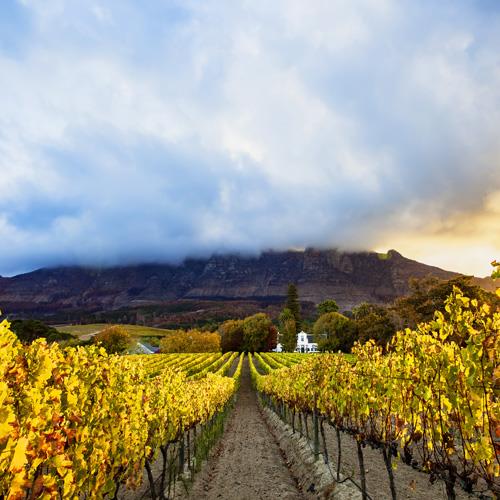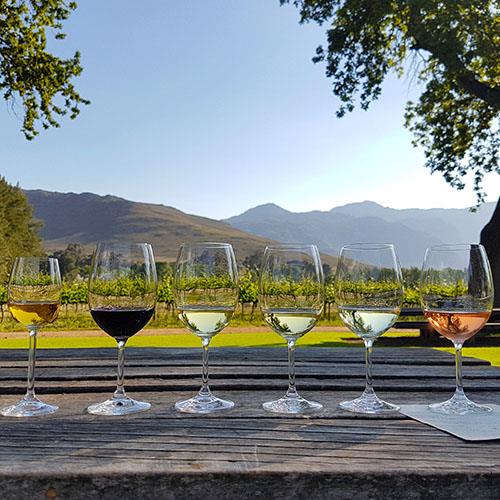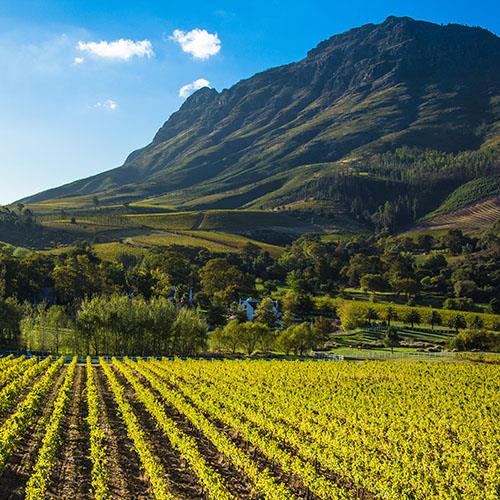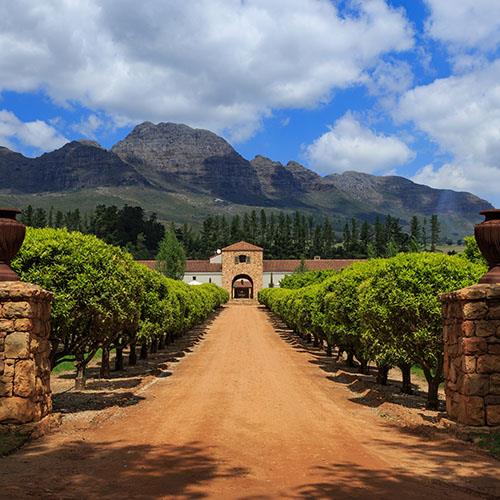Top South African Wine Regions


Cape Town
The historic Constantia Valley is a world-renowned floral kingdom nestled on the southern slopes of the magnificent Table Mountain range. The recently designated district named after Cape Town incorporates the wards of Constantia, Hout Bay, Durbanville, and Philadelphia. The region is known for its winemaking and was previously the site of Simon van der Stel’s 17th-century wine farm and the palace where Constantia dessert wines originated from and were famous during the 18th century throughout Europe. South Africa is one of the most prominent wine-producing countries in the Southern Hemisphere, boasting over 300 years of winemaking history and often referred to as the gap between the Old World and New.
The Western Cape region is where most of the country’s wine industry is located, among the lush, rugged landscapes, the abundance of mountains, valleys, and plateaus attract winemakers and allow them to produce a diverse range of styles. Verdant Vineyards in the climb up the east-facing slopes of the Constantiaberg. The vines here benefit from the cool sea breezes from False Bay. The vineyards of Durbanville lie close to Cape Town bordering the northern suburbs, with several estates and wineries to visit that are nestled in various aspects and altitudes where a variety of wines are produced. Sauvignon Blanc is a notable wine in the region as well as Semillon.
There are vineyards in these wards that grow at altitudes of up to 1,246 feet above sea level. The wines here that attract the most attention are Sauvignon Blanc, Chardonnay, Merlot, and Cabernet Sauvignon. Constantia is located on the peninsula to the south of Cape Town where it is almost surrounded by two oceans. This region is best known for producing Klein-Constantia’s Vin de Constance which is a world-class sweet wine. The cooling sea breezes help to retain acidity in the grapes. The southern suburbs of Cape Town are where the first vineyards of South Africa were planted. Some of the noteworthy estates here are Klein Constantia, Groot Constantia, Buitervenwachting, Constantia Uitsig, and Steenberg.


Franschhoek
The Franschhoek Valley features a distinct French Huguenot character, a small yet significant wine region surrounded by the Drakenstein mountains. Franschhoek is regarded as the ‘culinary capital’ of the Cape, a member of The Delice Network of Good Food Cities of the World with a profusion of trendy restaurants serving up delicious food accompanied by world-class wines. The Franschhoek valley is enclosed on three sides by towering mountains, with streams that slope down to the valley floor and converge to form the Berg River.
Franschhoek Valley is a broad vineyard lined valley home to South Africa’s most famous wine estates, the region has been producing wine since the 17th century. There are a wide variety of soils and relatively high rainfall in the region that allows for a production of a variety of wines styles including Shiraz, and Cabernet Sauvignon, along with Cap Classique sparkling wine made from Chardonnay and Pinot Noir blends. Franschhoek is easily accessible from Cape Town with wonderful day trips to stunning vineyards and wineries set amongst some of the most stunning scenery in the country. The topography here is the ideal setting for viticulture, allowing for vignerons to control the aspect to maximize sunshine hours.
The region is blessed with a warm continental climate which is ideal for the production of heavy, robust red wines, and rich, fruit-driven whites. The surrounding mountains help moderate temperatures, and reduce the amount of sunlight reaching the sprawling vines, particularly on the south-facing slopes which feature high trellising systems that are used to catch the passing sun. The region is largely made up of alluvial sandstone with deposits of granite on the mountainous slopes. Sandy slopes on the lower mountain areas drain rapidly while those heavier soils closer to the river have some water retaining qualities.
Franschhoek or “French corner” in Dutch still retains a heavy French influence since the 1600s when exiled French Huguenots brought viticulture to the area and planted the first vines. Many of the vineyards in the region feature French names and influences, which can also be seen in the town’s architectural style. The region is often regarded as one of the sexiest destinations for wine lovers in South Africa. There are luxurious accommodations, a plethora of top-rated restaurants, and spectacular mountainous scenery to enjoy, along with award-winning wines.


Plettenberg Bay
The Plettenberg Bay wine region first planted its vines in 2000, it is the newest and furthest appellation up the east coast of South Africa. Home to some of the most beautiful white sandy beaches in the country and a favorite for beach holidays. The town is brimming with a wealth of natural beauty, excellent whale watching, and home to one of the most scenic wine routes in the Western Cape. There are vineyards set in this cool climate just 1.86 miles away from the sea, other vineyards sprawl along the slopes of the Tsitsikamma Mountains on the border of verdant forests and sparkling oceanic vistas, with a route stretching from Harkerville to the Crags.
There are 18 official producers in the Plettenberg Bay wine region, it was awarded Wine of Origin status in 2005. The Plett region is fast making a name for itself producing Method Cap Classique and other wines such as Pinot Noir, Chardonnay, and Sauvignon Blanc. There are currently three wine estates in the region; Bramon, Packwood, and Plettenvale, the other wine farms and growers produce and bottle their own wines at the Bramon Wine Estate under the assistance of winemaker Anton Smal. Caroline and Peter Thorpe own Bramon Wine Estate planted their first vines of Sauvignon Blanc in 2001, resulting in an MCC (Method Cap Classique), the are currently produces eight MCCs and have been dubbed the “Bubbly Route”.
Visitors can visit the spectacular local wineries and sample delicious wares in the Plet region with wonderful wine tours and tastings. Enjoying the wines and stunning scenery while taking part in fun activities such as walking through the Winelands on horseback, on a horse-drawn carriage, on a cycling trail, or with a guided hike are all possibilities in the area. There are a plethora of outdoor activities to partake in including fishing, hiking, bird watching, and MTB, with farms in the area that have restaurants and picnic areas. The region is often touted as the up-and-coming champagne-style wine region of South Africa, the small, family-owned, local wineries and wine experiences here are quite intriguing with excellent wines on hand. Many of the Plettenberg wineries have received various awards for their wines in the past few years, all of them are definitely worth a visit.


Stellenbosch
Stellenbosch is a historical town known as the “town of oaks” featuring some of the finest examples of Cape Dutch architecture, and a winemaking history and traditions that date back to the end of the 17th century. Stellenbosch University is the only university in the country that offers a degree in viticulture and oenology; many of the country’s most successful winemakers are alumni. This spectacular wine region is located just a short distance east of Cape Town, it is the leading wine area in South Africa home to many of the leading estates in the country. There are over 200 wine estates and producers in the region including some of the most famous names in Cape wine.
The mountainous region is fringed by verdant vineyards and home to a mixture of historic estates and contemporary wineries the produce excellent examples of almost all the noble grape varieties, especially known for the quality of its blended reds. The wine route here takes wine lovers through several different trails, there are several different sub regions here and the geology is quite complex. The Stellenbosch district is divided into several smaller vinicultural pockets that include Banghoek, Bottelary, Devon Valley, Jonkershoek Valley, Papegaaiberg, Polkadraai Hills, Simonsberg-Stellebosch and Vlottenbury. The Stellenbosch Wine Route is the oldest in the country and one of the most popular tourist destinations in the Western Cape.
Wines produced in the Stellenbosch region including the savory and complex South African Cabernet Sauvignon, South African Syrah is taking the country by storm, and the dark spiced fruit-flavored wine with a chocolate richness. Some of the most recognizable wine-growing areas in the Western Cape are found in Stellenbosch, which is the second oldest settlement after Cape Town. Home to some of the popular names such as Kanonkop, Meerlust, and Thelema, the region excels at producing Bordeaux-style blends along with Pinotage, South Africa’s signature variety.